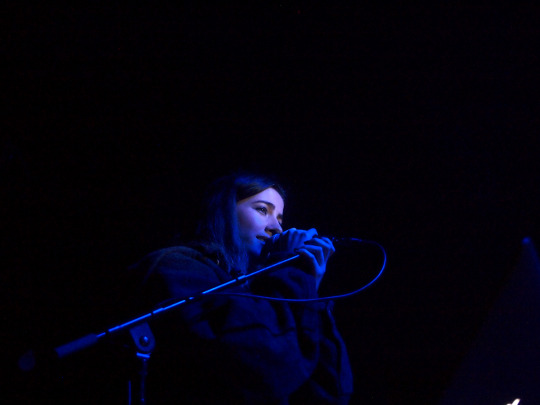Text
“We’re very much adults; We’re contemporaries”: DiS Meets Ablebody

Originally published 11/3/16 via Drowned in Sound. Photo by Michelle McCausland.
In the past six years, Christoph and Anton Hochheim—identical brothers known for their affiliation with The Pains of Being Pure at Heart and The Depreciation Guild—have settled back into the westerly gridlocked sprawl of Los Angeles. Now separately based in the eccentric hillside suburbs of Echo Park and the beachfront resort town Santa Monica, both brothers still tour with the Pains, perform on occasion with Dent May, and contribute to their own projects. Anton drums for the queencore band Hit Bargain while Christoph has tinkered meticulously with Ablebody, a personal vehicle that has evolved from gauzy soundscapes and remixes to enigmatic sophisti-pop. The latter’s payoff is the debut album Adult Contemporaries: ten tracks tagged as melodramatic pop songs spanning two separate periods of Christoph’s life—pulling from innumerable far-flung influences like Prefab Sprout, Burt Bacharach, Kate Bush—and an idiosyncratic cover of The Servants’ ‘The Sun a Small Star’.
Christoph greets me outside his residence in all-black thrifted attire with bedhead hair: he spent much of the day finalizing the album’s lyric sheet, subsisting off LaCroix Pamplemousse. He laments that Anton could not be with us.
He offers a can, and we head up the stairs to his room in a two-story flat at the heart of Echo Park. The walls are cramped with Kate Bush and Pains posters, recording equipment, and a sunburst Mustang guitar. We break bread over the sparkling water brand’s resurgence and meme status, before considering the most important question: is Ablebody’s debut album title Adult Contemporariesa jab at the genre recently dominated by Adele?
Christoph passes off the blame; according to him, it was Anton who conceived the deceptively innocuous idea. “We had a long text thread and [Anton] threw that one out. And we both immediately knew that was the perfect title for it, for a few reasons. There’s a slight nod at adult contemporary music, which we’re self-conscious that maybe this record is slightly tinged in—it’s something most people would consider cheesy, either in the chords or the production. There’s something romantic and flowery about this record that people, who don’t like adult contemporary music, would not like.
I think this was more a jab at ourselves than the genre. I think also there’s the acknowledgement that we are getting older, as people. My brother and I just turned 30, so we’re not really kids doing this anymore. We’re very much adults; we’re contemporaries.” This admission comes at the tail-end of a lot of personal reflection and reconciliation for Christoph, who conceived of Ablebody during a tumultuous period of his life: he was dealing with a fair amount of feels from past relationships, and since he began rolling with the Pains in 2009, tour life had worn him out.
“I think it was just the wear and tear of the road mixed with meeting people on the road who had been doing it for a lot longer than I have, and seeing either where they were physically or mentally, just seeing how that sort of lifestyle worked out. And I think pretty much across the board it was a disappointing experience, and one that actually threw a lot of red flags in my face. Like—is this really taking me someplace that I want to be?”
While on tour, Christoph drafted the beginnings of Ablebody strictly on a laptop, a limitation he felt was neither helpful nor fruitful. If not for the perfect opportunity, Christoph admits he might not have had the bravado to pursue Ablebody. “We had a month’s break before a pretty lengthy Asia tour, and it just seemed like a good time for me to leave, and they could get someone up to speed, and my brother moved back to LA a year prior to that, and I was sending him the demos and stuff.”
In time with the 2011 dissolution of The Depreciation Guild, Ablebody’s first fruits of labor were self-released without much fanfare: a four-track albumRemexès with—you guessed it—four remixes, including one previously released under The Depreciation Guild; an EP of covers for semi-obscure new wave and pop; and the taped-up, scratched-out feedbacking oddity ‘High Home’, the residuals of his shoegazing past.
As time went on, Christoph would bounce more ideas off Anton and eventually compile the All My Everybody EP, which featured a cover of Harry Nilsson’s ‘Sister Marie’ and the first psychedelic lovelorn rumination, ‘Sally Hot Jazz.’ Ablebody officially became the Hochheim brothers’ project after that release.
“I’ve always played music with my brother, and even him as just the sounding board is more valuable than most people might even recognize. Just playing things for him and getting a response and even having him rethink rhythmic ideas, or change the drum track, really does help bring things to light. So I think now it’s definitely a duo, at least in terms of the recorded output. It’s just the two of us.”
Because the presentation of Ablebody drastically shifted from solo bedroom project to recording duo, and finally to live quartet (with Daniel Rosenbaum and Jordan Sabolick), Christoph maintains that a lot of considerations were taken to maintain cohesion and authenticity in Adult Contemporaries.
“[Songwriting] is a very singular experience, and a fairly isolated one, and it’s not until the final stages where I design something…to expand on that with more the idea, of how we can make this a more palatable expression live. But we pretty painstakingly maintain a lot of aspects from the demos and did our very best to maintain the spirit of spontaneity in the final product, which I do think is something that I’m still figuring out and something that I struggle with all the time.” To harness the raw spirit of a single-take demo is quintessential to achieving that spontaneity, Christoph explains. It’s something he hasn’t quite mastered, but not for lack of effort.
“I think there's something sacred with the demo, the moment of inception of the song. I think it’s pretty audible, and I think there’s something with that moment where, if you can capture it in a hi-fi way, it could be the final product. At the time I wrote a lot of these songs, I didn’t have a lot of equipment to make what I was demoing the final product. With the latter half of this record, I’d say most of the tracks are pretty close to how I had initially envisioned them, and we just took huge blocks of sound from the demos. Putting my mic on the floor of the bathroom, and playing guitar or something. We’d spend hours trying to recreate that and realize that the original demo tracks are better.”
Under direction from producer Kenny Gilmore (Ariel Pink, Nedelle Torrisi, Angel Deradoorian), Christoph and Anton worked in a converted studio garage for entire days, tracking instruments and vocals judiciously, without pitch correction software. “It was a pretty intense experience just trying to make something that feels real in a situation that I don’t find the most comfortable, having my producer and my brother standing right there. So it was a learning experience for me.”
I ask if the lyrical weight imposed any emotional difficulties, or whether it was therapeutic to sing day-in and day-out on relationship retrospectives, self-doubt, and claustrophobia-induced madness (“Gaucho”) to jangly chord voicings.
“Maybe even the act of just singing them every night is the therapeutic part. But I think the act of writing it isn’t necessarily that. It’s kind of an exercise of just placing myself back in that space. And I put in a lot of work to remove myself from that space, at least for the first half of the record, with songs that were more directly influenced by particular occurrences. I think at that time it was all I could write about. I don’t know if it was difficult; I was pretty numb at the time. But it was at the forefront of my mind, and I just generally have a liking for sentimental pop lyrics. There’s a certain inherent truth and universal appeal to it. It just doesn’t seem like there’s any point in trying to write any other type of song, which is funny considering Kate Bush is one of my biggest influences ever, but she doesn’t write that way lyrically.”
Kate Bush’s lyrics—stories often tackling sensitive, darker topics like incest and suicide—were predominantly laid onto lush and upbeat melodies. And Ablebody’s musical output, while not nearly as taboo, is definitely inspired by the juxtaposition of bleakness with buoyancy.
“I don’t necessarily like the sound of morose music; I think that’s something I used to be into and I think that’s a product of growing older. Morose music sounds very heavy-handed and I feel like the emotion it’s trying to portray just immediately sounds nullified to me. But the saddest music is very hopeful and optimistic-sounding, and that’s just a more potent space to work from.”
He crosses his legs and sips the LaCroix.
“The sound of a defeated person with nothing left but a happy song to whistle is much more tragic than just somebody moaning and complaining to a modern chord progression,” he says matter-of-factly. But whether the composite character is moaning and complaining or whistling that happy song, Christoph practices restraint when drawing from his own inspirations; he’d much rather go over it all with a Gaussian blur. While songs like ‘Heartkeep’ endeavor to be more transparent, others like ‘One Dime A Day’ and ‘Powder Blue’ are inextricably nebulous, forcing listeners to add context from their own lived experiences.
“I’ve never gravitated towards lyrics that were very particular and I think a lot of traditional folk music for me is a little too heavy-handed in references. I like to paint as broad strokes as possible so anybody can insert themselves into the song. I think that’s what I love in the lyricists that I respect greatly. It’s something that I make an effort to do.”
That’s one of the reasons Ablebody has taken almost five years to complete Adult Contemporaries: after laying the structure and arrangements to each song—considerably easier given his background as guitarist, sound engineer (Anamanaguchi’s Endless Fantasy), and score composer (Someone Else’s Heart)—Christoph focused much of his time devising and revising the lyrics. A passion project like Ablebody can afford the luxury of time, but Christoph sees the benefit of project deadlines; he quips that it’s felt like a lifetime getting Adult Contemporaries out. “When we were finishing this record, I think we were all experiencing a loss in perspective, so I was asking everyone for opinions just because I had no objective sense in it anymore.” Future releases, Christoph says, will have definitive schedules and might venture into minimalist territories—he’s always had a thing for concise structures and prominent vocals. “I’m just really excited for the next formation of Ablebody, which I think is something people will like, that’s a bit different, a lot less contemporary. I just want it to be something that I feel is being misrepresented in this musical climate and...”
He trails off into thought before recomposing. It might not even be under the Ablebody moniker if listeners and critics pigeonhole the project’s sound. But Christoph’s not one to make forward-looking statements; everything’s up in the air. “I feel like I’m being too oblique about this and I don’t want to put any misconceptions as to what the new formation is gonna be anyways. But I just want it to be a very different presentation and musically to be something people haven’t heard from me, or in general. Hopefully.”
The sun has all but set—Christoph’s expression is illuminated only by a warm lamplight. I thank him for taking the time to speak with me, and he smiles.
“Thanks, I wish my brother were here.”
0 notes
Photo
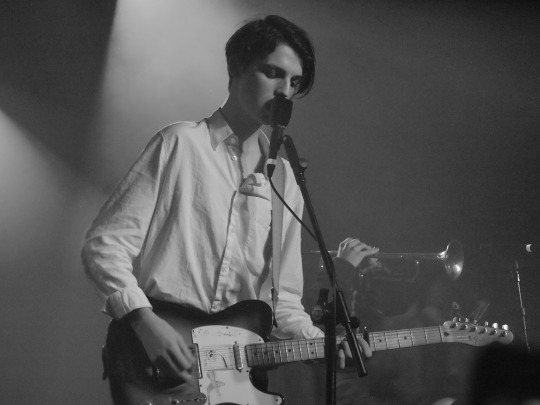

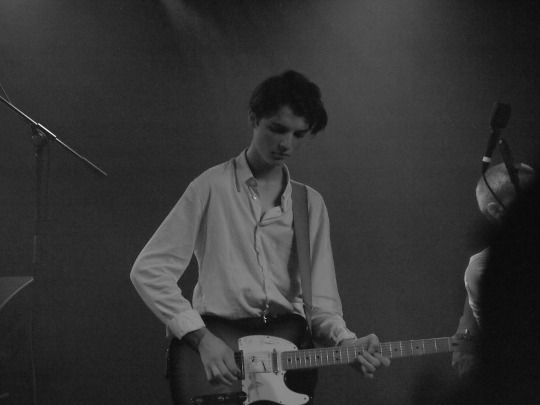
Slow Hollows at Teragram Ballroom 11/4
2 notes
·
View notes
Photo


Plaster Cast @ SXSW 2016
Listen to “Permanence”
0 notes
Text
Interview with Zeon Gomez of Ulzzang Pistol

Originally published 4/29/2016 via Culture Collide.
At mid-morning in Manila, electronic singer/producer Zeon Gomez has just put down a song — one for a beauty client — with his project Ulzzang Pistol.
There’s audio-pixelation in the call, and a hint of chagrin in his voice that crossfades to Filipino politics, which Gomez was browsing up until our interview. He tells me it’s also election season in the Philippines, with a potential conspiracy chained to it.
“It’s not just a little bit [of corruption], it’s really a lot. Every time we’ve had a presidential debate, the recurring question is on corruption. There are questions about same-sex marriage, divorce, the economy, but it’s just really focused on how you’re going to deal with corruption. That’s one of the biggest problems here.”
“A lot of people,” says Gomez. “Especially in the music production community, some of them are just trying to play dumb or stay innocent of the problem. Philippines doesn’t have a Bernie Sanders; we don’t have this obvious choice. Everyone’s either a nut job or really suspicious in a way. So I’m just trying to see what every candidate’s point is. There is no super obvious candidate but,” he sucks his teeth.
“I think it’s our duty to vote still — I can’t boycott it so I’m just looking at the next possible option and I’m just trying to catch up as much as I can.”
Gomez doesn’t bite his tongue when it comes to talking about the Filipino music community — he’s spent much of his life involved in the local scene, and believes in maintaining creative diversity. Part of this means calling out corruption when he sees it, even if it earns him a bad reputation.
“People think there is a lack of acts here, but it’s not because we don’t know what fits — it’s because you’re not looking, it’s because these big corporations tell us there are only these good acts here in Manila. Actually, there are so many.”
I ask Gomez for a shortlist of recommendations. He almost immediately brings up Similar Objects, an OG of the Manila beat scene, and a founding member of the BuwanBuwan Collective that once included Mark Redito (fka Spazzkid). Other name-drops include BuwanBuwan label-mates Nights of Rizal and rhxanders, and rapper/producer ANKHTEN BROWN.
“Filipino underground music sort of is flourishing, but it’s doing the cha-cha right now. One step forward, one step backward. I guess I’m speaking with electronic music in mind; I don’t have the knowledge to speak about bands. We kind of do our own things for the most part.”
Gomez definitely follows suit. With Ulzzang Pistol, Gomez is simultaneously producer and curator, emanating internationalism and combining Japanese dance, Korean pop, Irish shoegaze, and American chillwave under one name. His 2014 debut album Girlfriend was an internet success, imbued with vaporized electronica, Japanese lyricism, and a cadre of international artists like Sarah Bonito (Kero Kero Bonito), Yikii Tong (Yikii✿M18), and Achi (MARGARET SPOON). With this effort Gomez had hoped to broaden native Filipinos’ musical horizons, who at the time were catching on to future beats and abstract hip hop.
It didn’t catch on.
Instead, the album was received largely by Asian Americans. The cross-pollination also motivated Japanese listeners to discover other Filipino musicians, and served as a foundation for Ulzzang Pistol’s collaborative endeavors.
Two years later, Ulzzang Pistol’s sophomore album follows Girlfriend as another collaborative effort with several Korean musicians who are mere glimmers in the Asian music scene. Aptly titled Waste, the album is comprised of 10 exquisite corpses —house and chillwave grooves sutured together by K-indie soul.
“When I did Girlfriend, I gave [the collaborators] an idea to write on this theme... With Waste, I gave them the album.”
The songs stand at the crossroads of the political and the personal: Gomez’s conscious decision to include seasoned musicians like Yukari and Oh Hee Jung is a resistance to the irresistible Hallyu wave that has been sweeping the world, fronted by idol groups like Girls’ Generation, BTS, Apink, and Big Bang.
Simultaneously, Waste resonates a shared despondence from the perspective of under-exposed talent. In its most vulnerable states, the album is a grim reminder of the near-crippling self-doubt that independent artists face daily.
“There is this feeling that so many people are doing the same thing or better and everything is a waste — some of them aren’t even blowing up in their own country. I reflect to them what I see in myself.”
It’s a self-deprecating statement that Gomez doesn’t take lightly; he’s seen this waste firsthand. Driven by the musician’s dream, he first compromised friendships and a romantic relationship when he played in a pop punk band through college. Crestfallen after the band split, Gomez graduated with a degree in graphic design and took up the corporate mantle for a time.
“And then I had a crisis: what do I want to do? I want to do music so much, but it wasn’t getting anywhere, but then again at my job as a graphic designer back then, [it] felt like I wasn’t growing.”
Gomez would later manage his younger brother’s project, No Rome, and learn to produce music. He began to survey the Manila scene from a music business perspective, and understood it as a microcosm for the global music community. Bouncing back after stints in an indie pop band and a new wave project, it became apparent to Gomez: “This nepotism and bias and sense of entitlement exists everywhere.”
And so Ulzzang Pistol became the answer to the question: how can you promote musicians without relinquishing sincerity and becoming a cog of music marketing? Casting aside his personal struggle, Gomez turned outward to support peers across the geographical expanse. Knowing that his collaborators have since grown in popularity is a reward in itself for Gomez.
“At the end of the day, it’s me and them getting together, making a song, and showing people this is what a Filipino-Korean track sounds like. It’s a way to get people intrigued by these artists and hopefully look them up to get into them. “
Beyond Waste, Gomez hopes to separate his political passion to rekindle his personal struggle — varied international acclaim has not given him an opportunity to play a live set in his home country. He’s resolved to move Ulzzang Pistol towards greater introspection in a (possibly) Tagalog follow-up, while moving artist collaborations into a separate project. He hopes to “make a compilation of Asian acts who are undeniably good, something you can relate no matter your ethnicity.” It sounds like a heady goal, but if reception from Ulzzang Pistol’s first two albums are any indication of progress, then Gomez need only hold out a little while longer.
0 notes
Text
Interview with Son Lux

Originally published 4/7/2016 via CREEP Magazine. Photo by Sean Pressley.
It was December and the morning air was palpable.
It was cold.
I had a double-shot of espresso—not the best idea when you’re about to talk with one of the most quixotic trios in Western music. I’m not trying to exaggerate Son Lux either—critics have largely described his music as “suffocating,” “pretentious,” and “almost too ambitious to be listenable.” Any other musician would find it difficult to swallow the opinions of tastemakers with excess popism and buzzword vocabulary.
But Ryan Lott chooses instead to count his blessings. And today I caught him on a good afternoon—he operates on Eastern Standard Time—to talk candidly about the 2015 album Bones and offer a counterpoint to critics’ reactions.
As with most days, he was busy writing—already two songs in, one of which was new Son Lux material, and the other which was for Hanna Benn, a singer who had written some vocal arrangements on the Bones record. Two cups of coffee into his day and with one dog-walk down, Lott ventured to make some toast. He burned it.
“I need some sort of drug to maintain steady output; six or seven different tracks a day I’m working on sometimes, so my drug of choice is caffeine.”
In his daily grind, Lott keeps his coffee habit balanced with equal sips of water, and works across several different projects to maintain productivity without falling victim to artist’s block. “It’s yin and yang,” says Lott, who had his water bottle taken by his wife yesterday, and was subsequently parched by the evening. This belief in the compresence of contrasting forces not only plays a substantial role in Lott’s life; it’s inherent to Son Lux, and evident in Bones’ bit-crushed beats, digitized choirs and circuit decay. The textural, rhythmic and formal juxtapositions aren’t incidental, aren’t a product of knob-happy experimentation or last-minute panic.
But when a review casually mistakes an electric guitar for an acoustic guitar while saying it’s too much to take in? “That’s a red flag,” says Lott.
“If you can’t differentiate that, then the music would be difficult to take in. If you are a little more knowledgeable and have a little bit more training, you can tell that a song in 5/4 is pretty adventurous rhythmically for a folksy song, especially Americana folksy.”
He pauses.
“Maybe it is too much to take in. I hope I make music that is difficult to take in. However, I think what you bring to recordings as a listener is a huge factor.”
“From a lyrical standpoint, it matters a lot to me that people bring their own stories and experiences. I’m not a storyteller, and I’m not trying to tell stories, but maybe I am trying to invoke some stories. Even if they’re not narratives, they’re still personal. One of the reasons I do this is I really value about music the perception that varies from person to person, and with that variance, the possibility for myriad meanings to emerge. And I think that’s kind of a magical thing.”
Lott’s fixation on the subjective aesthetic experience informs even his deliberately opaque lyrics. He skirts around questions that he says would “shut off a kind of moment of revelation, even if it’s a tiny one in the listener, if I talked about what the song is about.”
That’s a tough break for some music critics, who, Lott feels, “are guilty of being clearly a writer writing about music with a bias towards words.”
He doesn’t necessarily blame them either. He can’t.
“That’s the world that they’re coming from, that’s their passion, and that’s what they hopefully spend a lot of time doing… But it’s like, sometimes I get flak about not being specific enough in my lyrics, and I think some reviewers just haven’t done enough to understand something that’s very intentional.”
This intent goes far beyond a numbered score; beyond a string of genre descriptors; beyond a measured state of (dis)pleasure and a cadre of similar sounds. One of his cohort, guitarist Rafiq Bhatia, extrapolated of the song “You Don’t Know Me” socio-political interpretations, no doubt charged by current world events. But that’s only his point of view. Others may peel meanings far different and more personal, that take a dialectical approach to expound on signifiers in sonic form and structure. Because our thoughts are capable of encompassing more than what we like or dislike.
That is what Son Lux, in its current tripartite form, aims to achieve. That is what almost every critic has failed to understand.
“And that’s the thing with us—we’re all geeks and we’re all interested in exploring contrasts not only from song to song, but also internally. We’re not aiming for a target on some sort of genre spectrum—that’s not how we create music and that’s not how we listen to music.”
So why do we act like it?
0 notes
Text
Interview with Golden Daze: Art School Beginnings, Craigslist Sales, and Home Recordings

Originally posted 2/29/2016 via The 405
Midwestern transplants Ben Schwab and Jacob Loeb have settled into the rhythm of Los Angeles life, despite being musical outsiders to a scene dominated by surf and garage rock. Raised on ‘60s psychedelia and folk, the two have hand-sculpted a sound that resonates hypnagogic warmth and narcotic nods—a mixture of eras, elements and emotions as idiosyncratic as Fever the Ghost, Deep Fields or Mild High Club. After a handful of years navigating congested freeways and loading zones, they’re ready to do what any sensible musician does: tour. Now, the duo are prepping for the album’s February 19th release via Autumn Tone Records. But before the shows with Mikal Cronin and Jacco Gardner, before finding their dreamy lo-fi aesthetic, Ben Schwab and Jacob Loeb started at CalArts.
“That is a fact,” Jacob says after we sit down in the patio of Stories Café in Echo Park. Ben slides his elbow as he rests his chin on his hands, revealing a pack of Marlboro Golds in the pocket of his tattersall shirt. Shaded by his Bernie Sanders baseball cap, Jacob chews on a toothpick as he flips through his memories.
“My first memory of it was, I walked into a room where Ben was playing—I don't know, it had something to do with Jon Brion.”
Ben confirms. “Yeah it was; you liked Jon Brion.”
He turns to me.
“The people who like Jon Brion tend to like other people who like Jon Brion, because there's not many people who like Jon Brion.”
It was a start. But not the official start of Golden Daze. Back then, Jacob was studying theater; Ben, music.
“We were just friends; we lived together. I moved to Portland for like a year and a half. And then,” he points to Jacob.
“You came up on a trip to write, to just hang out—Golden Daze [still] didn't exist at this point, we were just writing songs.”
Jacob smiles as he peels a sliver of the toothpick, placing it neatly on the red plank of a table.
“Yeah, on that trip I took up to Portland —mostly just to visit Ben— we kinda unexpectedly wrote a lot, and it was like, really fun basically. And we're like, ‘Damn we should keep doing this, too bad we live on other sides of the country.’ But we ended up sending each other material over the next half year, year or so, until Ben moved back to LA and then it was kinda time.”
He straightens his back. His fingers fidget as he looks for an opening in that worn down piece of wood.
“To me, that trip to Portland was kinda like the birth of what Golden Daze would become.”
We timeskip to their fateful Craigslist selling experience, where the two inevitably met their lo-fi acid house producer and friend Palmbomen (née Kai Hugo), whose recent release Palmbomen II was inspired in part by a lengthy X-Files binge.
“I mean, it's exactly what it sounds like. Ben was selling his TEAC on Craigslist, and Kai walks in. The joke of the whole thing was Ben was selling his TEAC, but it was actually an ad on Craigslist searching for a producer.”
Ben interjects. “It wasn't actually that— we weren't looking for a producer.”
“No, but that's the joke of it, though!” Jacob reasoned. “We was just trying to sell a Reel-to-Reel but we ended up meeting one of our best friends now, the guy who helped us to produce our record— “
“—who we would have never met otherwise because he's in a whole different scene of electronic music. He was originally from the Netherlands. There would have been no other way to meet someone like that. But I think it had a weird positive influence on us.”
Ben was right. Palmbomen rolled extensively in Europe’s late-2000’s electronic scene, briefly as the filthy bloghaus duo Ganz Nackische before his induction to French electronic label Maison Kitsuné.
In contrast, Ben was pulling backslides for Xsjado and writing folk music. Jacob was working under James Franco in the Bukowski biopic, weaving bedroom pop under the imagined persona BABY BLUE.
“The cherry on top was that the TEAC that Ben ended up selling to Kai was used throughout that record. So in a way, the thing that we sold to Kai, that brought us together, is also what gave our record whatever character it has.”
That je ne sais quoi has been evident in previously released singles “Low”, “Salt” and “Never Comin’ Down.” But weighing equally with Palmbomen’s magic touch were the influences spanning decades. Initially taking inspiration from The Beatles, Todd Rundgren and Simon & Garfunkel, the duo eventually moved on to washed melodies of dream pop and scuzzy textures of shoegaze.
Meager finances played an equally significant role. Jacob’s fingernails peeled off yet another chewed-out splinter of wood. Ben quietly nibbled on the corner of his thumb. Running up several thousand dollars’ worth of studio time was not their prerogative.
“I think a lot of bands try to go beyond their means to get this professional sound, but we just didn't have those resources so we didn't want to pretend like we had. We kept it pretty minimal. But Kai is also experienced with DIY home recording too, so we just tried to make it sound as good as we could for what we had.”
The sun was all but settled, and we wrapped up acknowledging the donkey in the room—Jacob’s public, however apprehensive, display of support for Democratic presidential candidate Bernie Sanders.
“I've never, in my life, felt compelled to be outwardly supportive of any political figure. Even as I wear this hat, I have some hesitation to wear it.”
Ben wasn’t vocal about his political allegiances, but didn’t see anything wrong with it. Many prominent musicians, from Lil B to Thurston Moore, have repped the Vermont senator. To Ben, it was merely a repeat of history, a throwback to the countercultural revolution.
“That used to be a big thing, like in the '60s to early '70s. It just doesn't exist anymore. I think the younger generation wants that, in a way. I've talked to friends from different bands who've said that. There's this feeling like, it would be nice for kids and musicians to be politically active, but there hasn't been a right person to support.”
“It's just been out of fashion or something, out of style,” Jacob observes.
“I think it's a thing now, a little bit.”
Ben shrugs. Jacob turns to me.
“Politics aside, who would you rather hang with? Who would you rather have a beer with?”
He drops the last toothpick splinter, curled like a golden blade of grass, in with the rest.
0 notes
Text
Top Acid’s 1 Year Anniversary

Originally published 2/11/2016 via Lo-Pie.
I’ve heard a lot about Chris Gonzalez, the made man of Orange County’s DIY music scene. About how much he’s helped aspiring creatives. About how his venue/collective Top Acid is only a one-man operation. About how his shows never get shut down by the police.
It sounded like a DIY urban legend. Like maybe “Chris Gonzalez” was the pseudonym for a shadowy group of kids with good connections and large trust funds. Or some young puppet strung up to a business-minded puppeteer.
But he is real.
Aimee Murillo, an OC Weekly journalist who covered Top Acid’s owner last year, described Gonzalez as a big humble goofball with a sense of humor, among other things. She knew a few sentences wouldn’t suffice, wouldn’t even capture a fraction of his character.
“I feel like you just have to get to know him,” she told me in an e-mail.
And I was determined to do just that at Top Acid’s 1-Year Anniversary show on February 6th.
When I arrived at sunset the vendors were still setting up in the open French Plaza outside of Wursthaus. The intersection on French and 4th was congested, and about twenty people set up shop, laying out clothes, artwork, and design-your-own-pins. I walked along the sidewalk, surveying the preoccupied faces for someone who stuck out.
None of them did. So I flagged down a man and asked. He pointed to the body hoisting speakers and rolling orange cables out on the plaza’s stage, set just under graffiti art that read “Santa Ana East End” — the same outside stage from Way Too Fun Fest. A smartphone was plugged into the PA system, blasting Bauhaus’ “Dark Entries” as Chris Gonzalez sang into the microphone and fiddled with the levels.
“Does anybody have any tape? Like, duct tape?”
Old televisions, mannequins, and painted boxes sat on each other. As I walked closer, I saw, in great detail, his faithful black chucks all blasted and weathered. The carabiner with a bottle opener hanging from his waist. A Harley Davidson shirt covered with an American flag stood out patriotically. On his turned cap were the words “Desert Storm, Persian Gulf” sewn in gold, with laurels flanking the brim, shielding his hair but not his Duchenne smile. A black and tan Chihuahua paced around him. As Chris Gonzalez turned to focus on me, he seemed to know exactly why I was approaching him.
We introduced ourselves, shook hands, and Chris apologized for not answering my message earlier in the week. It would take a few more hours to get actual words in with him; amps had to be placed, and sockets had to be plugged.
But the wait was not awkward. It was not boring, annoying, or tiresome.
Because I got to watch the anniversary show build itself to Chris Gonzalez’ music playlist.
“Roses” by Outkast.
“Night of the Living Dead” by Misfits.
“Staggered in Lies” by Sacri Monti.
“White Lies” by Dirty Fences.
Vanilla smoke came from three teenagers sharing a Swisher to my right. We started a half-hour late — the longtime Latin jazz, last-minute add Flying Hand came short of performing a David Bowie cover, but rocked heels and stopped passersby. There were maybe 40 people now. More were jaywalking over.
As the studded leather jackets and flamingo mohawks squeezed through, Seaweed Party opened the pit, played a Violent Femmes cover, and dove in. They weren’t even set up on the stage, and they didn’t care to be. No one cared, least of all the police, whose cruisers lurked a block down.
On stage, the girls of VAJJ were tuning up, and in lieu of a mic stand, keyboardist/vocalist Alexia Del Alcazar elected to use a boy. I forgot his name, but I did remember that Julie Manoukian dashed into the pit while photographers maybe twice her age apprehensively backed up. The floor was a divine wind of flying fists, stomping boots, and perspiration.
And I, transfixed by the whirling bodies, hadn’t even noticed Hollow Ran as they set up in the corner.
After VAJJ’s set, Chris offered to answer my questions and referred to Top Acid in the collective pronoun “we”. It’s really just him, though. He has a certain way of doing things, which is why it’s been this way.
“I’m not a control freak,” he reassured. And I didn’t think so, either.
This year, he had been given the privilege of curating shows at the Yost Theater on weekdays. There was a bigger budget, which meant there would be bigger festivals for 2016: Way Too Fun Fest and East End Block Party. Chris would later explain via online communiqué: Chup Fest was considered a mini-fest catering to touring acts or bands with smaller followings (read: less than 1,000 fans) — the turnout couldn’t compare to the other two.
His attention was half on me now, and I couldn’t blame him — there was no safety net at Top Acid, nobody to make sure things were going smoothly except Chris. The crowd shifted, and we split. Math spilled out and sputtered — Trevor Magaña’s snare caved in. Everyone sort of looked on — some out of respect and others in awe — and it wasn’t until one and a half songs through that kids started dancing, even though, Chris said, they probably didn’t know that they were dancing to math rock.
He was grinning; it was a good thing, I think.
Chris would later walk in all calm during Girl Tears’ set: once to fix the mixer settings, and then again to take pictures. The monitors buckled as Kam Andresen shouted and croaked. Tristan Ellis had to check the bass amp twice, but no one was complaining. The pit had taken on a character of its own, held back only by the pauses between hardcore punk songs.
There was barely time to breathe; Mechachief revved up in the middle of the square almost immediately after Girl Tears stopped. And just like that, Top Acid’s owner was gone again. Drummer/vocalist Chris Segura, with a black-and-red changshan and mic duct-taped to his neck, was thrashing the cymbals and toms. A face-wrapped Kevin Menenses frantically clawed at his 12-string. And the crowd devoured itself from inside out.
What started almost half an hour late wound up with over a hundred people on the ground, lining the balcony, and a full hour left for San Francisco’s shoegazing LSD and the Search for God.
No energy to mosh — barely any to stand.
The spiked jackets and colored hair regained composure, but they didn’t leave. Nor did the languid tees and vintage boots. Cops didn’t stalk the cross-streets. Parents didn’t shake their heads. No one booed. No one heckled. No one started any fights.
I combed the crowd to find Chris once more, to thank him for his hospitality before driving home. I found him once more, and as he leaned over to hug me, asked if I enjoyed the show.
Yes, I did.
0 notes
Text
Chanelle Rezko of Get Born

Originally published 11/30/2015 via CREEP Magazine, photo by Kane Ocean
A split exists in the skateboarding identity.
Outsiders don’t know too much about it. When asked about skateboarding, your average Millennial can probably namedrop Tony Hawk, and maybe Tech Decks if they’re a late ‘90s kid.
But this split exists.
In the span of a half-century, skateboarding has grown from its roots in surf culture and carved its initials into all forms of media. It’s an emblem of rebelliousness and youth, proudly used by Marty McFly, Bart Simpson, and Max Goof. Since its boom in the ‘90s, kids in every city have gotten into skateboarding, with about 11 million casual and core skaters in the world and thousands of skateparks. The largest one, over 12,000 m², was built in Shanghai. You have these brands like Quiksilver, RVCA, Vans, and Hurley that establish themselves in the community and finance teams of professional skaters in major events. Once Nike and Adidas got into the mix, things really blew up. Skating became accepted as a sport — the Olympic governing body is even considering its inclusion for the 2020 Tokyo Olympics.
This comb-over mainstreaming is half of its counterculture history: the industry’s dynastic struggles for power, discussions on authenticity and etiquette, and countless technical innovations from the polyurethane wheel to the Ollie. Skateboarding’s foray into punk music has cultivated anti-authoritarian and anti-establishment attitudes, i.e. a deep suspicion for anyone who tries to disrupt or profit from its existence. This punk influence, combined with a DIY roots mentality, motivated skaters to explore and integrate new modes of expression into skateboarding. Coming up from VHS, print media, and film photography, skate culture has grafted itself onto the Internet, publishing rich think-pieces on corporate takeovers, skatemetrics, and inclusion.
Which brings us here, in this vast digital space with Chanelle Rezko.
Some writers document skaters. Chanelle Rezko, founder of the online platform Get Born, documents skate culture.
She was heading out of Concordia University to get some work done for her site when I called. Along with friends Liv Seidel, Hope Christerson, and Ayda Omidvar, Rezko is one of many Millennials actively revitalizing skate culture.
Chanelle’s passion starts in the northern suburbs of Chicago back in 2004, where she learned to skate with her older brothers’ hand-me-downs, ’90s street brands like World Industries and Zero — “Back when Zero was cool,” she adds. She also watched a lot of skateboarding videos.
“It was just an interest that I had picked up on, because I was really attracted to it physically — it’s so aesthetically pleasing, and it was just something that I took a lot of interest in rather than other things like soccer or dancing. I would just choose skateboarding over everything else.”
Then in junior high, seventh grade to be exact, Rezko met Liv Seidel and Hope Christerson.
Their mutual interest? Skateboarding.
Mutual friends? Skateboarders.
The three were drawn to each other.
“It’s like this magical kind of dangerous feeling that’s... still indescribable today.”
Instead, Rezko described her adventures with Seidel and Christerson. Breaking into school after-hours. Running from cops. Getting into trouble and living on the edge, or as far on the edge as teens holed up in middle class suburbia could go.
“The only thing that was exciting that came out of that town was skateboarding. We’d ditch class and go to the skate park and stay out until midnight and get into other trouble. It was a way to channel all our teenage angst and frustration.”
After graduating, Rezko gave serious consideration to pursue skateboarding, but not like Elissa Steamer or Lyn-Z Hawkins. In an earlier interview with The Fridge Door Gallery, Christerson recalls her friend’s words:
“For me, Chanelle had always been saying, ‘I love skateboarding and watching skate vids but I don’t skate, so I don’t know what to do with my life. I have this passion and I don’t want to be on the side lines.’”
During her first year, Rezko self-actualized.
“When I moved to Montreal for university that’s when I was like, ‘Okay, I’m becoming an adult and this is either a hobby or I’m going to make this my life and try to pursue it as an actual career.’ I started planning creative outlines and creative concepts as a way to channel all of our passion and energy. I presented it to the girls and they were down, and we just started working on Get Born.”
Seidel and Christerson moved out to Montreal too, where the three met Ayda Omidvar, a Vancouver transplant with a penchant for collages, photographs,and skateboarding.
At first, things were easy — even the magazine title, which was taken from Bob Dylan’s “Subterranean Homesick Blues”, fit in effortlessly. The focus was wide, and the style lay somewhere between the Instagram-worthy editorials of FIND YOUR CALIFORNIA and the print-bound grunge of New York-based 43.
“We just want to showcase and expand a more authentic definition of what skateboarding means to us. That’s what we’re aiming to give to people.”
But then came the footwork: covering brand-sponsored events, covering the local scenes, and interviewing the press-shy. The Get Born crew received mixed reactions. Some interviewees would decline on basis of gender. Some disagreed with Get Born’s pieces. Others said the four were simply wasting their time.
“People in the industry, out in California, have been seeing it as a good business — different, unique, something that’s going to come up in the industry. So we get backed up by those people, but locally it’s been a bit difficult. Just walking into premieres or events, people don’t really take us seriously. I don’t know why they don’t, because we work very hard and we take ourselves seriously. It’s like our crew of girls that are there, and then it’s all these dudes, and then there’ll be another crew of girls and they’re just the girlfriends, you know?”
Sexism is an apparent problem in skateboarding — about as systemic in the industry as any other — despite the list of notable skateboarding women. OGs will tell you about Patti McGee, Ellen O’Neal, Cara-Beth Burnside, Peggy Oki, Kim Cespedes, Cindy Whitehead, and Laura Thornhill among other great skaters in the ‘70s. Because of skateboarding’s tricky definition (it could be considered a sport), people have come up with essentialist arguments as to why there aren’t more skateboarding women, or according to Nyjah Huston’s 2013 statement, why “skateboarding is not for girls at all.”
Incidentally, traveling sports writer Tetsuhiko Endo published an exposé on the gender-biased history of skateboarding to debunk this notion that women are physiologically unfit for certain sports. His observations highlighted an industry preference for younger men from the ‘70s onwards — sex advertising was an effective sales driver, and mascots like Rosa (Shorty’s Inc.) and the Hubba Girls (Hubba Wheels) attracted buyers as much as pro skaters did.
This last decade has been a turning point — the skating boom has launched pro women back into the scene, and their coverage has in turn inspired others to take up skating. It’s been a rough drive and the gender pay gap still applies to pro skaters. Recently, Leticia Bufoni won the first SLS Nike SB Women’s Super Crown World Championship, taking in roughly $40,000 in winnings. Kelvin Hoefler, by comparison, took home $200,000 for winning the men’s division.
While there are more inclusive and critical publications like I Skate Therefore I Am and Jenkem Magazine, it’s still an uphill struggle for gender equality. As one of the forerunners, Rezko feels the brunt of it. But she’s not phased.
“It’s like, no one really knows why we’re there, but yeah. You just have to walk in with confidence and make it your goal; that’s what we’ve been doing. I hope more and more people can see this as it continues.”
The hard-work rhetoric sounds clichéd, but it’s paid dividends for Get Born. Larger publications routinely go for pro skater interviews and competitions. Rezko goes for people behind-the-scenes. They might be more difficult to track, but they’re often some of the coolest people her crew’s ever met — Mandy-Lyn Antoniou, Chris Contesso, Bing Lui, and others showcase the unquantifiable creativity inherent in skate culture.
“We want to focus on the underground aspect of skateboarding, what still remains real to us. And that’s the [videographers], the people working on creative projects, local skatepark builders who are trying to make the city thrive. People who are big in the industry have received so much coverage.”
That doesn’t mean that she or the girls won’t call the scene like it is. Gonzo journalism informs the Get Born aesthetic, and Rezko’s crew is often invited to cover major skate events. It’s very honest.
“We’re getting flown out to big contests like Mountain Dew, Street League (SLS) — like, ESPN events. We attend these industry events but we’re trying to document it and make it into our own and give our own perspective on it. It’s not necessarily that nice of a perspective, but we’re still going to keep that core and that underground feel to the content no matter what.”
This extends to interviewees, too. Rezko was upfront in a recent interview with pro skater Paul Rodriguez as he talked about his skate documentary We Are Blood in a room full of PR and marketing groomers. She was equally frank with Chris Nieratko, former writer for the defunct magazine Big Brother, about the shit he’d seen and done. Both the magazine and Nieratko had been big inspirations to her — Rezko saw this as her personal breakthrough, the sign that Get Born was for real.
“That’s when I was like, ‘Fuck yeah, this is happening.’”
Get Born is rapidly expanding its coverage beyond hometown Chicago and new home Montreal, out to the UK and the streets of Los Angeles. They’ve taken on some new writers and photojournalists. Vans Canada recently sent them some footwear to showcase.
“But other than that we’re just going to work hard and keep doing what we’re doing.”
Marginalized by law enforcement and whitewashed by pop culture, skateboarding is in constant existential conflict. Despite great financial gain, there’s great uncertainty in its future as corporate interests encroach on the skateboarding identity. Will skaters of today remember the struggles of their predecessors? Will society’s fringe reflect on its history of discrimination and rise above it? Will the boundless digital space capture the “last creative genius” that is skateboarding? In totality? In finality? Chanelle thinks so.
Stay true, and keep things core.
1 note
·
View note
Photo

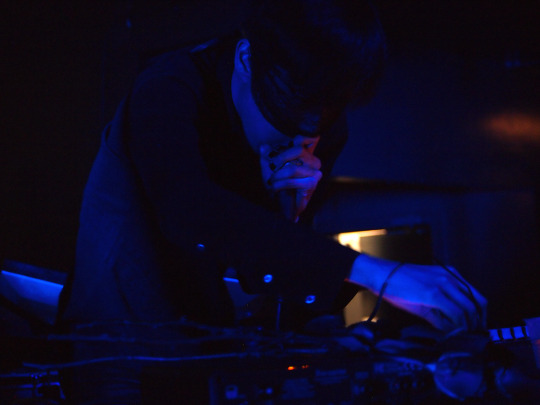

@meishismile at The Echo, 1/22/15
16 notes
·
View notes
Text
Naytronix: Mister Divine

Originally published 1/12/16 via CREEP Magazine.
Nate Brenner doesn’t think of Mister Divine as a concept album. That assumes painstaking effort and calculated direction — and that simply isn’t Naytronix, which has been playful and robotic and weird since the electro-funk debut Dirty Glow. Back then, the bassist of experimental pop project tUnE-yArDs had used Naytronix as an outlet for his unhinged, if inconsistent, creative endeavors.
Three years later, the collage of sounds are still laid back and loosely improvised. Some of them came up while Brenner was co-writing Nikki Nakwith Merrill Garbus (tUnE-yArDs), and some came up while touring. Some started as parts for his DJ sets. Some were pieced together with the Haitian polyrhythms he’d learned from Daniel Brevin.
But loose as they might be, the ideas in Mister Divine emanate a very serious, very existential matter, “...dealing with and thinking about the past, present, and future, while ultimately trying to make sense out of life,” as Brenner puts it in an interview with Catherine Elliot. This time, the Oberlin graduate puts his post-apocalyptic robots aside to casually level with some Baudrillard and Lao Tzu.

Stepping away from his vocoder, Brenner openly waxes on the gloss of hyperrealism (“Living in a Magazine”), cubicle-induced altschmerz (“The Future”), and the nag of perpetual déjà vu (“I Don’t Remember”). Not in a downer sort of way or anything, but more like passing trains of thought.
Fleeting moments of brutal honesty that can go either way.
His murmurs might be mixed with illicit quantities of the obscure and funky — Arthur Russell and Bootsy Collins, William Onyeabor and Stevie Wonder. And that, coupled with the unorthodox rhythms, might trip up listeners who have only felt the thump of the downbeat. But the heart of Mister Divine’s anodyne melodies courses the blood of tryptamine-laced Americana. It’s the closest thing that Naytronix has ever come to a simultaneously accessible and eclectic pop album. As experimental musicians lambast and struggle in the pigeon-holes of music genre — whether to innovate or distinguish — Brenner has stumbled on the heuristic process of making the ephemeral memorable: don’t think too hard on it.
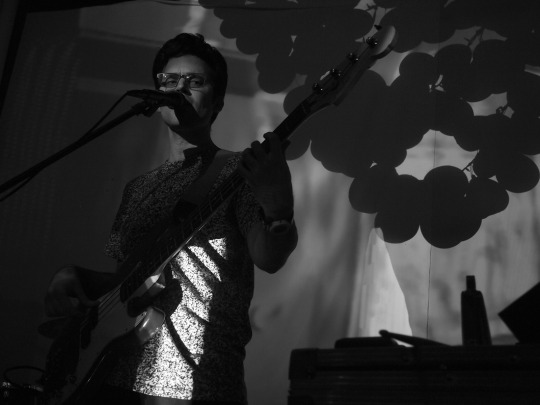
For all its disparate influences and intersecting cast, Mister Divine is undoubtedly genuine and creative, pieced together from the disjointed ideas of Nate Brenner’s subconscious. The hooks and the triplet beats and the contours of the groove, embellished with the tiniest particles of noise, gives the album an asymmetric slow burn, with just enough color to provoke closer attention.
Is it avant-lounge? Intelligent dance muzak? Post-world music?
Find a string of descriptors to make sense of Brenner’s sophomore album, and you’ll find a string of descriptors to make sense of your life.
All of ours, at that.
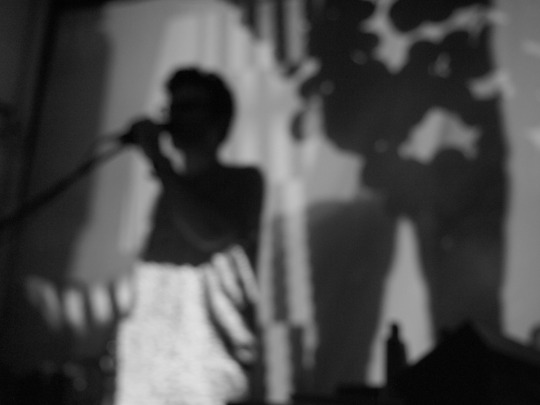
0 notes
Photo


Miya Folick at Bootleg Theater, 12/03/15
24 notes
·
View notes
Photo

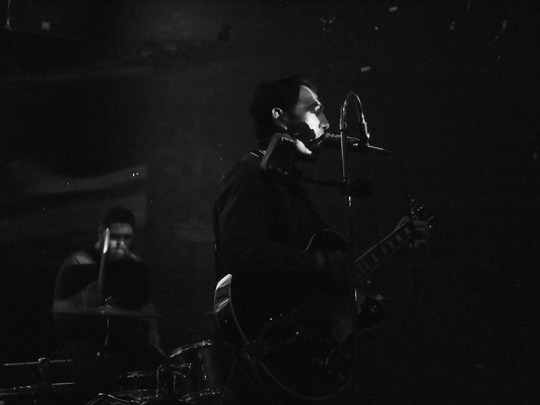

Mind Monogram at The Smell 11/20/15
3 notes
·
View notes
Photo



Tamaryn @ Echoplex, 11/12/15
5 notes
·
View notes
Photo



Miya Folick @ The Echo, 11/11/15
2 notes
·
View notes
Photo




James Supercave @ The Echo, 11/11/15
0 notes
